Mrs. T and I got serious with investing in dividend growth stocks around 2011. Since then we have built up a sizable dividend portfolio, generating around $3,400 per month. Our goal is to one day live off dividends.
While accumulating a basket of diversified dividend growth stocks can be a very reliable investment strategy, it can take a long time to build up a sizable portfolio to generate steady dividend income.
Often the best way to build up a sizable portfolio and a sizable dividend income is to use a buy and hold strategy. But are there other ways to potentially accelerate the timeline and generation additional income from dividend stocks over time?
As it turns out, there is a way to do this. It is called earning options income with dividend stocks.
For this post, I have asked Liquid from Freedom 35 Blog to explain more about options strategies for dividend investors. Liquid is a fellow Vancouverite and recently retired early in his mid-30s. In addition to dividend stock investing, he has been deploying options strategies to generate additional income each month.
Please take it away Liquid!
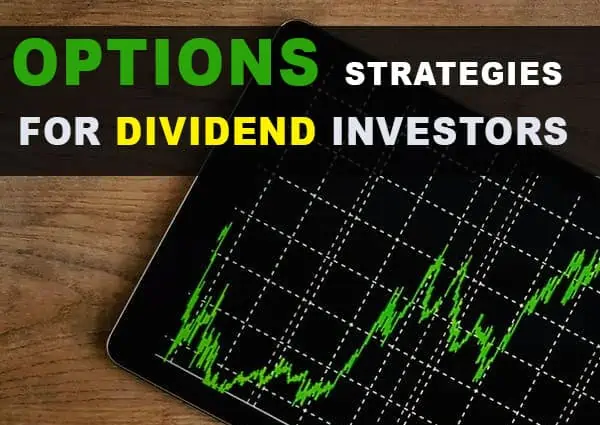
Thanks Tawcan.
Let’s go over the basics first.
What are options
Options are financial derivatives that give buyers the right, but not the obligation, to buy or sell an underlying asset such as a stock or ETF at a predetermined price, called the strike price, within a specific time period.
There are many opportunities to profit with options. But the particular way I want to explore today is designed to sustainably generate recurring income. Options don’t replace your stocks. They actually work together with your existing dividend portfolio to boost your income and total returns. 🙂
There are 2 types of options, calls and puts.
Think of options as a hedging tool against rising or falling prices.
How do call options work
Imagine that you’ll receive a bonus at the end of the year. You know you want to take all of this money and invest it in Enbridge stock (TSE:ENB) because you want to retire early and live on passive income.
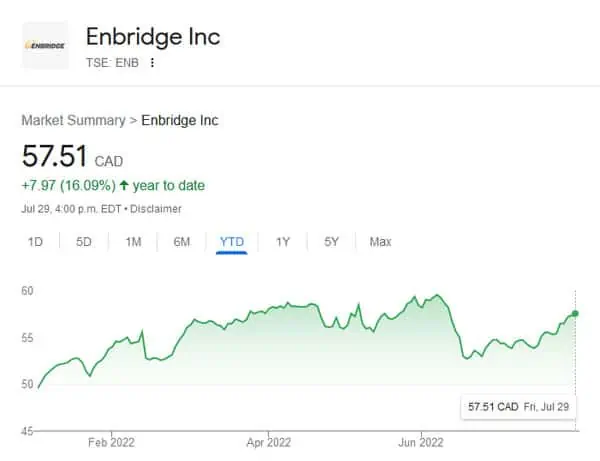
Current share price as of writing this post.
But you have a case of the FOMO and don’t want to miss out on any potential stock price appreciation from now until you receive our bonus.
So what you can actually do is lock in a purchase price that you want to buy it at. Let’s say you purchase a call option contract and choose $60 as your strike price. Doing so will allow you to purchase the share at $60 if you want, until the expiration date, which let’s say is Jan 2023.
At the end of this current year in 2022 when you receive your bonus cheque, if the stock’s price increases to $100/share, you can simply exercise your option and still purchase the shares for $60 each instead of the higher market price. You can see how this optionality has value for you.
That’s how call options work in a nutshell.
How do put options work
On the other hand, investors who already own a stock may want to buy some insurance to protect themselves against a stock market correction. They would want to buy a put option contract, which gives them the right to sell their shares at a fixed price. Individual stocks can unexpectedly fall by 70% or more, like Shopify did this year.
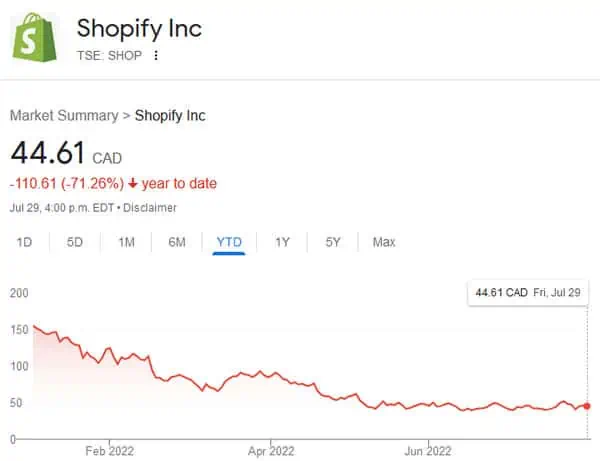
But a shareholder who had purchased a put option in early January, maybe with a strike price of $150, could get out of their stock position now without taking much of a loss. Again, you can see the value in this kind of insurance policy. This is how put options work.
Wherever value exists, people will pay for it. This gets to the heart of making long term income with options. You can become the person who sells options to those looking to buy them.
When you sell a call option you’re selling someone the right to purchase 100 shares of a company from you at a certain strike price prior to an expiration date. Because they gain additional flexibility they have to pay you.
When you sell a put option you’re selling someone the right to sell 100 shares of a company to you at a certain strike price before an expiration date. The buyer gains an insurance policy to limit their downside risk so they have to pay you for that insurance protection.
In both cases, you will receive cash up front for the optionality that you are providing the option buyers. This payment to you is called the option premium and it’s how you can generate regular income with options, month after month.
Let’s take a closer look at how each type of strategy works.
The covered call
One practical way to implement call options is to sell a covered call. This is useful for investors with long stock positions. The strategy reduces risk in stock investments while providing profit potential when the stock remains flat or even increases slightly. By selling a call option against your stock position you create more than one way to profit. 🙂
Before setting up this options trade you will require at least 100 shares of the underlying stock. Then you can sell a call option. Each option contract represents 100 shares of stock.
This is called a covered call because in case the option buyer decides to exercise their right to buy the shares from you, you are “covered” since you already own the shares and don’t have to buy them from the open market.
Let’s take a look at an example of a covered call on a dividend stock like Apple (AAPL).
AAPL is currently trading at $162 per share as of writing this post. If you have at least 100 shares of Apple you can sell a covered call.
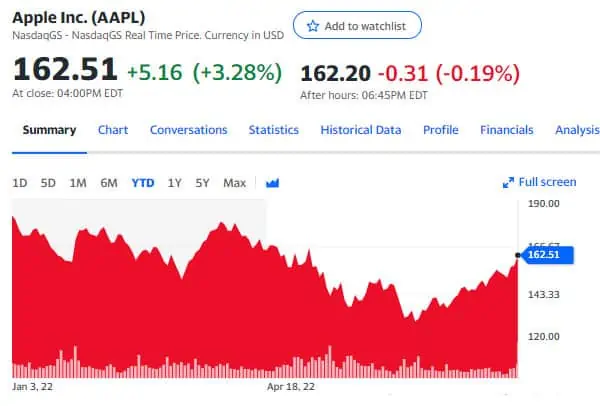
You start by looking at the option chain for the company. This should be available in the discount brokerage that you normally use to trade stocks.
If you choose a strike price roughly one month away, with a Delta between 5% and 10%, this will give you a high probability of making a profit.
Using IBKR, the trading platform I use, we can see that a call option expiring on September 2nd (35 days away) has a Delta of 0.066. This means that Apple stock has a 6.6% chance of expiring in the money with the strike price of $180.
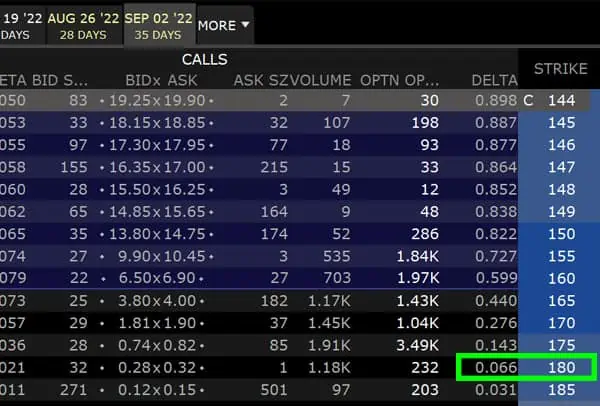
In other words, there is a 93.4% chance that on September 2nd, Apple’s stock will be lower than $180 per share. As an option seller, you want this to happen. You want the option to stay out of the money so it expires worthless whenever possible.
On September 2nd there is no reason for the option buyer to exercise their contract (to purchase 100 shares from you for $180) as long as the price of Apple in the open market is below $180 per share.
And for selling this option, you will receive a premium, which is your payment that is determined by the bid and ask price, which as you can see above is 0.28 and 0.32 respectively. Let’s split the difference, and assume you can sell the option for $0.30. Keep in mind that one contract represents 100 shares. So you will actually make $30 before trading commissions.
Then on September 2nd, one of two things will happen.
Either Apple shares remain below $180/share, or it closes above the strike price.
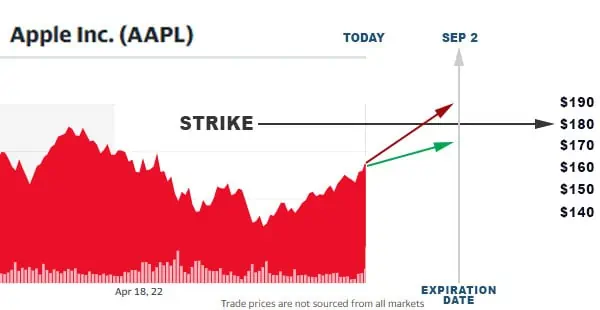
Most likely the share price will end below $180 on the expiration date.
For example, maybe AAPL closes at $170 per share on that day (green arrow in the graph above.)
In this case, the option expires worthless, and nothing else happens.
But in the less likely outcome that AAPL closes above the strike price, such as $190 per share (red arrow) then your 100 shares of stock will be called away, forcing you to sell them for $180 each.
No matter what price AAPL lands on at expiration you will get to keep your $30 premium.
The big downside to selling a covered call is that if a stock price increases substantially you actually won’t participate in all of those gains. By selling a call option against the shares that you own you agree to sell the shares at the strike price of the call that you sell, even if the stock price will be above that call’s strike price at expiration.
Hypothetically speaking, even if AAPL’s share price climbs to $1,000 by September 2nd. Your profit from those 100 shares under contract is capped as if the share price was just $180.
There are ways you could avoid losing your shares, but no matter how you approach it, if you sell a call against your shares of stock and the stock price explodes your profit potential would be far less than it would be if you had not sold the call.
A covered call gives you extra income, but you give up some upside potential. In this example, I think it’s worth it because if Apple shares do rise above $180, then that’s still 11% higher than today’s price of $162.
Making 11% in 35 days is over 100% annualized. I would be okay giving up the potential to make more capital gains with Apple stock, if I’m already making 100% return using options.
To improve your chance of success, consider only selling covered calls during certain favourable conditions, such as:
- During periods of market overvaluation. Getting an overpriced stock called away is not such a bad thing, especially when you can enter the stock again when it becomes cheaper. More on how to do this later using put options.
- When you hold slow growth companies. You can maximize your returns from a combination of dividends, call option premiums, and capital appreciation.
- When your stock has become relatively expensive and you want to rebalance your portfolio. Instead of selling your overvalued stock, you can begin to generate extra income and returns from it by selling covered calls at strike prices that are well above the fair value estimate for your stock. Then, if the stock’s price happens to increase above your strike price, forcing you to sell it, you can re-allocate that capital from the proceeds towards more undervalued investments that you’ve been hopefully keeping a list of.
So a covered call is a great strategy if you are mildly bullish or bearish on a stock that you own, and is not something you would use if you’re extremely bullish on a stock and you want all the upside potential that you can get.
The good news is that most of the time stock prices don’t explode to the upside. And by implementing a systematic covered call strategy you can create a stream of profits when the stock price remains flat or even increases slightly over time.
But what if you don’t already own 100 shares of the stock? Can you still generate income using options? The answer is yes. And you can use a put option to potentially buy yourself 100 shares of a stock at a discount to the current market price.
The cash secured put
The best way for dividend stock investors to use put options is by selling cash secured puts, or CSP. This means you write (sell) a put option that is out of the money.
The trade is most profitable when the stock price remains above the strike price as time passes.
The “cash secured” part of this strategy simply refers to the fact that you have the cash available to purchase the shares should the option gets exercised. This is less risky than selling naked puts where you don’t have the money on hand.
Selling put options is a great way to buy a stock if you believe it’s a great business but is just too expensive at the moment. You can set a lower purchase price so that you only have to buy the shares if the stock price drops below that level.
That’s why it’s really important to set a strike price that you are comfortable buying the underlying stock at.
The downside of selling a put option instead of simply buying a stock is if the stock price continues to climb and never drops down below the strike then you will miss all of the upside gains from the stock.
So selling put options should be used when you believe a stock will either move sideways or slightly down, but not when you’re very bullish on the stock.
Let’s take a look at an example of selling a put option.
We can use Apple again because we are already familiar with the stock.
Start by looking at the option chain again for the September 2nd expiration date.
This time we’ll focus on the put columns.
We’re looking for an option that has a Delta of somewhere between -0.05 to -0.10. It’s negative this time because put options are inversely proportional to Delta. But the idea is the same.
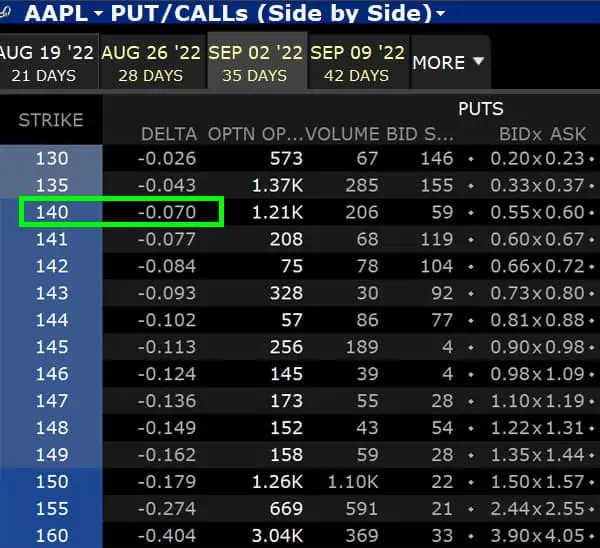
I have selected a strike price of $140 with a Delta of -7.0%.
The payment you would receive for selling this option right now is about $0.58 per share or $58 for 1 contract.
On the expiration date, one of two outcomes will happen.
Apple shares will close either above or below the $140 strike price.
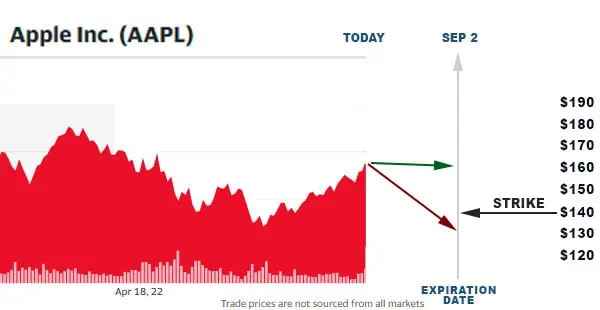
This put option will only be exercised if AAPL expires in the money, below $140/share on September 2nd.
The green arrow represents a slight decline from $162 today to $160. In this scenario, nothing else will happen and you can sell another put option to continue earning premiums.
The red arrow represents a more substantial fall of the stock price to $130. Since this is below the strike price, the option buyer will exercise their right to sell you 100 shares of stock for the strike price of $140 per share.
Even though this price is more expensive than the market price at that time, it is still considered to be a discount relative to today’s price when you initially sold the put option. If you don’t believe Apple is worth $140 per share today, then you can pick another stock that you believe can be bought at fair value using this put option strategy.
You basically get paid $58 (your premium) to buy someone else’s Apple shares for $140 any time before the option’s expiration date. If you run this put option strategy on a monthly basis you will earn about $600 per year from just collecting put option premiums.
The cash you need to set aside is $140 x 100 shares = $14,000 in case you need to take ownership of the shares. This represents a 4.3% annual return ($600 / $14,000)
So you can basically earn a decent yield on your money while you wait for one of your put options to be exercised. And when you do get assigned the shares you will buy the stock at a price that you believe is fair.
Below is a live demonstration of how to set up and execute put options
The downside to selling a put option with no protective legs is that you can overpay for a stock relative to the market price on expiration.
If for some reason Apple shares fall to $90 per share, to use an extreme example, you will still need to pay $14,000 to buy 100 shares, even though your shares would only be worth $9,000 at that time. This means you would have a $5,000 mark-to-market loss.
This is why you should always be comfortable with the strike price before you sell a put option. Because you just might take ownership of the shares.
For long term investors, paying $90 per share for Apple today would be an absolute bargain given its future cash flow projections. So even if you get assigned a stock for a higher price than the market, it should still be at a relatively cheap entry point relative to historical valuations.
Although the Canada Revenue Agency permits the use of certain types of options in registered accounts, I prefer to sell calls and puts in a non-registered account for maximum flexibility. Short selling and margin trading are not permitted in tax sheltered accounts for example. So if you have already maxed out your RRSP and TFSA, consider opening up a taxable account. Canadian dividend paying stocks should receive priority in a non-registered account anyway, so a covered call or CSP options strategy would complement the dividend income very well.
Combining the 2 strategies together
Both covered calls and cash secured puts are excellent strategies. To decide which one to use you just have to weigh your options. 😁
To make the most out of calls and puts alternate between the two. By selling a covered call you will inevitably be forced to sell your shares at some point. When that happens you can then sell a CSP to buy back those shares. And when you eventually are assigned those shares again, you can sell more covered calls. The whole cycle repeats.
There’s a term for this strategy and it is called the wheel.
Rolling with the wheel
The wheel contains 3 parts.
- Sell Put options to generate income. Most of these should expire worthless.
- If any options are assigned you sell Call options above the cost basis on the assigned stocks.
- If those stocks get called away, you make a profit from buying the stock low and selling high.
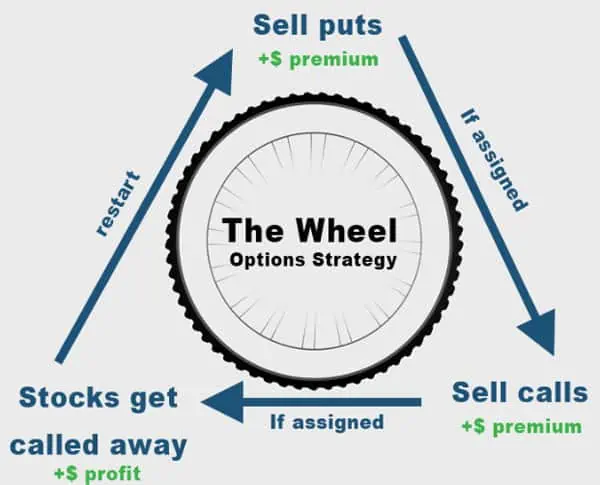
Since you can make money in 3 different ways this is also known as the triple income tactic.
The wheel can be thought of as an improved buy and hold strategy.
Here’s a video explaining in more detail how the wheel works showing real trades I made earlier this year.
Summary – Earning options income with dividend stocks
Thanks Liquid for writing up such a detailed post!
Covered calls and cash secured puts are the foundations of a good options strategy that can work long term for dividend investors who understand how to value a stock. They allow you to generate more income from your dividend stock or ETF portfolio at the cost of giving up some potential capital appreciation.
Other options tactics exist as well, but they all pretty much utilize the concept of time decay to earn a consistent income with controlled risk. You may have heard of the short strangle or iron condor. These require you to sell puts and calls that expire on the same day, but with different strike prices. The set up is a bit more complicated, but they’re simply just combinations of put and call options that work together.
Option spreads are another good idea if you want to have defined risks. You won’t make as much of a premium, but you also don’t have to worry about the stock price moving too much one way or the other.
As you can see there are a lot of different ways dividend investors can use options to earn some additional income on top of the dividends distributed by the stocks. Learning how to use each options strategy effectively will help you unlock some value in your portfolio to increase your overall returns.
The covered call strategy brings in regular premiums on top of the dividends that your stocks already generate. Selling a cash secured put option produces a stream of income for your portfolio, while you wait for the shares to be assigned to you at the price that you want. This way, any extra cash you may have lying around is constantly working for you.
When you’re facing an uncertain market like we are in 2022, it can be useful to diversify your investment income. So it’s nice to know that you have options.
Dear readers, are you using options as a way to earn extra income? I’d love to hear your thoughts on this strategy.


I’ve been selling options for over 20 years and it has proven to be an amazing method to supplementing income in tax efficient manner. It does not come without some ups and downs. One thing I learned the hard way in the past is don’t lured into the trap of early success and what sometimes seems like free money driving greed where you over extend yourself beyond what you can afford. An unforeseen event such as 911 or the 2009 financial meltdown can have devastating effects. Always use options within your means and you should profit greatly.
Options offer so much flexibility to profit from all types of market conditions and there are almost always ways to work your way out of a situation if your option strategy is moving against you (e.g. rolling out a losing option trade to a later date and/or more favourable strike price). There are endless strategies to deploy for every situation and any outlook you may have on a particular stock.
If you plan to get serious about options, I would also recommend IBKR as they have some of the lowest commissions (they even pay for trades on occasion when you create market liquidity with your proposed trade) and amazing option strategy tools. I was a longtime TD Waterhouse trader and I wish I had moved to IBKR earlier. I am saving about 80% on commissions.
Enjoy the options experience and watch your portfolio grow!
Great points Henry. I started with TD Waterhouse as well before moving over to IBKR. Best decision I’ve made in terms of lowering my trading fees. Definitely a recommended consideration for anyone looking to trade options on a regular basis. 🙂
There are some challenges to this strategy – which I’m not sure how to manage exactly.
In 2020~2021, stocks would go up so much that I’d always be called out and would’ve been much better if I just held the stock.
In 2022, stocks go down and up so much that finding the right strike price is very difficult because you don’t want to sell a call way below the strike price of the put you bought. For example, I sold 100~110 AMD puts when it was trading 120+, and got assigned when it dropped. When the stock is below 90, selling 110 call is very very low premium, but you don’t want to sell call at 90~95 because if the stocks makes a comeback, then you basically sold it at a lower price than you bought. You can wait until it comes back, but it could take several months – which you don’t get any option premium for a prolonged time.
So, this strategy is probably good when the market is very stagnant… but in a bull or bear market, doesn’t really work well.
That’s correct. It’s hard to consistently make a profit with the wheel if the market is very volatile. This is why it’s best to use this strategy on dividend paying stocks or index funds where the Beta is typically 1 or lower.
Dividend stocks are more stable and have held up really well this year compared to the broad market. The SPY index fund is diversified across hundreds of stocks so it doesn’t have large swings. There will still be times when it won’t be easy running the wheel on lower volatility securities.
Black swan events can push the market down 5% or more in a single day. During those rare times you may not make money from options. But in most times you will. The idea is that over a long investment period your options strategy should still average out to be profitable. 🙂
Basically my strategy
For the stocks that i am currently holding, I will sell CC at a strike price 10-15% more than the current price which are all above my cost price
For CSP, I will only sell CSP for the stocks that I really want to buy at the strike price that I am comfortable with. Normally at least 10% below the current price. Some even at 20-25% below current price.
Collect the premium in both cases and most of them will expire worthless. Sometimes I buy to close if I reach the target % return
Good evening
I don’t have option trading on my account.
So I need to open a new account
Do I need to open a short account if I want to sell csp’s ?
Thanks
John
Hi John. I don’t believe you need a short account in order to sell CSPs. But maybe it’s different with every brokerage.
I would love to learn how to use this strategy.
1. Check out Cash secure puts and Covered calls strategy first
2. Next you can purchase books by Lee Howell and maybe some other authors. These two strategies are very straight forward and simple to implement as long as you have a plan and stay put on your plan and not to be greedy. They are pretty boring strategies but very fruitful
Hi Gary, could I have the name of the books that is mentioned here please?
1. Get rich with Options by Lee Howell
2. Covered Calls for Beginners by Freeman Publications
3. Wheel strategy by Freeman Publications
Start with these 3 books first
Hey John. I also recommend learning the covered call and cash secured put strategies first. The videos above explain how they work. These are straight forward strategies as Gary pointed out, and excellent for beginners to learn. 🙂
One thing to consider with options is the fees. The brokerage I use charges about $1 per contract. But others may charge more. Since we want to limit trading commissions it’s something to be aware of. Let us know if you have any questions.
Thanks guys
I use TD web broker
So my commission is 9.99 a trade
Is the contract fee on top of the commission
Just got home and found it
TD charges 9.99 commission plus $1.25 per contract
Yes. This strategy of the Wheel option is a great one. I have started using it end May and has yielded a pretty decent amount.
Most CSPs and CCs will expire worthless or you can buy to close them earlier if your target return has been reached earlier.
Fantastic strategy
We may have to look into this more. Glad to hear the strategy is working well for you
Glad to share…
I learnt a lot from you on the dividend strategy as well.
Slow and steady wins the race….consistently
Insightful input, Gary. 🙂 And I agree. Combining CSPs and CCs is an excellent way to create some additional value from a stock portfolio. A lot of people like to do the Wheel on index funds such as the QQQ. This removes the risk of concentrating the trade on one individual stock.